Piner High School Gem
A few weeks ago I attended the Piner Highs School open house for their new high tech science building. The $3.6 million dollar structure, officially known as the Science Position Astronomy Research Quest Center, or SPARQ, was built to house the schools STEM (science, technology, engineering and Math) classes and contains an astronomical telescope, GIS and GPS technology, climate and meteorological instruments and a multi-axis planetarium.
Named by the Piner High Astronomy Science Club, the center uses astronomy in relationship to lessons about physics, mathematics, chemistry, biology and Earth science.
About 200 chairs had been set up in front of the building. As I walked to find a seat I was handed an event program by several students wearing “SPARQ” t-shirts. Looking up at the dramatic three story glass monolith that defines the new building I could see a large world globe suspended in the entrance foyer.
After being entertained by a trio of students singing pop tunes, Piner’s principle, Sally Brimrose, was the first to address the crowd. She thanked everyone involved and especially teacher’s Kurt Kruger and Kristi Erickson who were the driving force behind the project. Bill Carle, President of SRCS Board of Education, talked about how this building symbolizes the future of K-12 education.
Carlos Ayala, Dean of Sonoma State University’s School of Education, captured the moment when he broadcast three sounds from his smartphone and asked the audience to guess what they were. They were the beeping sounds made by the first “Sputnik” satellite; the sound of a “dial-up” connection to the internet; and the final sound was that of a melting an artic glacier. The sounds, he said, represent the evolution of the challenges and changes that have, and do now, face the world’s scientific community.
Shelly Nooner spoke on behalf of the Trimble Corporation, a manufacturer of Geographic Information Systems (GIS) positioning devices. She said that Trimble was proud to donate to the project and the equipment for the building’s GIS lab. The last speaker was Kurt Kruger who got choked up trying to express his gratitude for all who helped make this project a reality and what it will mean to all the students at Piner High School. Then the ribbon was cut and in we went.
My first stop was the planetarium. This marvelous structure is a visualization theater with an eight-meter highly specialized 24-foot diameter perforated aluminum dome and 100 comfortable chairs ringing the round room. The facility has a high definition projection system that displays three million pixels on the dome and is equipped with a full 5.1 surround-sound audio system for audio-visual presentations, and the lab has been designed with the flexibility to be used for lecture, individual and group work settings. The theater can also be used to project videos as well as images of molecules and DNA, for example, in addition to supporting other school departments like English Department classes. This is the first high school in Sonoma County with a planetarium.
Steve Carpenter, the school’s physics and robotics instructor, gave the demonstration. He explained how the dome was made of perforated metal which prevents the projector light from reflecting so the images can be seen. He showed images of the night sky during the summer and winter and pointed out the North Star at the end of the little dipper. Constellations were projected and some of the Hubble telescope images were shown. At the end of the presentation he said that donations are need to pay for more planetary programs which are “not cheap.”
At the end of the presentation I mentioned to Kurt that I thought they could raise money by presenting planetary “show” to the public as there is nothing like this facility north of the Morrison Planetarium at the California Academy of Sciences in San Francisco. He said that that’s a possibility but that they have to get their student programs in order first.
I next moved to the large, open tech room on the other side of the building. To the right was a section of the planetarium panel where people were encouraged to sign their names. The room’s exterior walls have large glass windows under which are a bank of 30 computer workstation’s with 24” monitors. In front of the computers was a row of table with students and teachers demonstrating their programs and activities.
The GIS is become a big part of the STEM program. GIS is often associated with making maps, but GIS professionals do much more than that. GIS is used to manage human activities. GIS professionals visualize, analyze, and model our world to help organizations make informed decisions. Many 21st century careers are associated with this discipline such as cartographic design; data analysis; computer programming; database administration; project management; system administration; business development, managerial, and administrative roles. In addition, the outdoor game of Geocaching and the sport of Orienteering use the GIS technology of satellites, ground stations, and receivers to create a Global Positioning System (GPS).
Piner’s Geospatial Technology Pathway program has gotten national recognition from trade periodicals such as “American Surveyor Magazine” for bringing GPS and GIS technology and local professional input to the high school classroom.
I next came upon a group of fifteen-year old students at the Health Science and Biotechnology table who were eager to show me how to test a food sample to see if it had been genetically modified. They showed me the micropipette in which the mashed food sample is placed along with a gel solution to separate the DNA from the rest of the cellular components. Simply stated, the DNA then needs to be copied many times because more DNA than is found in the food is needed for testing. This is done through a procedure known as Polymerase Chain Reaction or PCR in which the food DNA is unwound. The last step is to visualize the DNA and see if the DNA has been modified. This is usually done by gel electrophoresis. These students are a lot smarter than I was at fifteen.
I later talked with the class instructor Mark Mantoani who said that the curriculum for this class was designed by Sonoma State genetics students who each year design a customized lab experience curriculum for the genetics unit at Piner.
A senior in the Health Science class enthusiastically showed me the photo highlights of his internship at Memorial Hospital. He got accepted to Dominican College in San Rafael, California next semester and will be in the pre-med program. We talked about my high blood-pressure and I suggest that he study geriatrics as that’s the fastest growing demographic. I think he’ll make a great doctor.
I then got in the flow to courtyard behind the building. The refreshment table was mobbed by both hungry adults and students (after all, it was dinner time). The courtyard has an outdoor amphitheater for lectures, demonstrations and student gatherings. It is also where several of the “Maker” robotics projects are being built.
On one side of the courtyard stands a detached observatory which has a retractable roof and a 12½-inch PlaneWave telescope that can host public star-gazing events. The observatory includes a “warm room” where the telescope is controlled and images are viewed allowing more students to participate in the use of the telescope for longer periods, while remaining comfortable during cold nights.
Construction on the 5,000 square foot building, which contains solar panels and a 2.5-kilowatt wind turbine that pumps energy back into the grid and can provide recordable data that is used in the curriculum so students can correlate weather patterns with the effects on electric power generation, began in May 2012.
If high school tech buildings could be built on failing campus it might help stem the tide of student transfers and dropouts. Facing declining enrollment and faltering test scores for years, Piner has seen its student body dwindle to nearly half of what it was when Kruger joined the staff 25 years ago. Today, there are about 930 students. With school choice, students who live within Piner’s enrollment boundaries have for years opted to enroll at other Santa Rosa City Schools campuses or leave the district altogether. But backers say the dramatic glass-front building, coupled with renewed emphasis on science, technology, engineering and math courses, could help Piner stem the tide (no pun intended).
Of the total cost, some $2.7 million represents the hard cost of construction. An additional $510,000 was allocated for non-construction “soft costs” and another $285,000 for equipment. Initial funding came from a $1.7 million 1991 state Proposition 1D Career Technical Education School Facilities Program grant, based on the state’s 50-50 match standard for the original estimated cost of $3.4 million — the amount projected at the time the application was submitted. Additional funding came from an array of sources, including redevelopment fees, developer fees, private firms, other grants and donors. No general fund dollars were used, according to district officials.
SPARQ Center @ Piner High School
Science Position Astronomy Research Query
A foundation led by parents has been established to help keep equipment up to date and to link Piner students and teachers with industry leaders and local scientists. “It’s a state-of-the-art building. I don’t know another high school in the nation that has a building like this,” said Rui Gregorio, president of the fledging foundation. “The SPARQ Center is going to be a real good catalyst to say where that school is today and where it’s going in the future.”
In California there are about $159 million in unused Prop 1D seismic retrofit funds (out of $199 million) for the 7,000 plus non-wood frame K-12 schools. Maybe some of this money could be used as seed money for other high school tech building throughout the state. Also, some of Prop 39’s $381 million school energy retrofit funds might be used for the same purpose. Kwok Architects have designed a beautiful building one that could be duplicated many times over.
Piner High’s SPARQ Center is a shining light for not just tech education but all K-12 education. It shows students that teachers and parents care about their education and set an example of what hard work can accomplish. Teachers Kurt Kruger and Kristi Erickson should be very proud – they’ve created a legacy.
Project Snap Shot
- Piner High School Geospatial Science Center
- 1700 Fulton Rd., Santa Rosa
- Owner: Santa Rosa City Schools
- Construction Start: June 2012
- Completion: July 2013
- Cost: $3.7 million
- Construction management and cost estimator: Counterpoint Construction Services
- Architect: QKA Quattrocchi Kwok Architects
- Original design concept and CTE grant-writing: Bartos Architecture
- General contractor: Helmer & Sons
- Structural engineering: ZFA Structural Engineers
- Civil, mechanical and geotechnical engineer: Miller Pacific Engineering Group
- Civil engineer: Brelje & Race
- Mechanical engineer: 15000 Inc., Electrical: O’Mahony & Myer
- Financing: $1.6 million state career technical grant; $1.3 million in borrowing against future allocations of property taxes revenues from former redevelopment agencies; $206,000 from already-collected redevelopment fees; $243,000 in developer fees; $195,000 from 1991 bonds and $84,600 from career technical grants. No district general funds were used.
- Inspector of record: John Stocksdale
- Lighting: O’Mahony & Myer
- Interior design: Quattrocchi Kwok Architects
- Roofing: AnC Roofing
- Windows: Progress Glass
- Construction framing: Wheeler Construction
- Glass and glazing: Progress Glass
- Insulation: Empire Insulation
- Site grading and paving: Helmer and Sons
- Drywall: West Coast Drywall
- HVAC: Trahan Mechanical
- Rebar: Wheeler Construction
- Cabinetry and countertops: RR Laminates
- Doors and hardware: LML Enterprises
- Tile, flooring and carpeting: Floor Tech
- Masonry and concrete: Wheeler Construction
- Structural steel: National Metal Fabrication
- Painting and finishes: KBI
- Sheet metal: Trahan Mechanical
- Welding: National Metal Fabrication
- Observatory: Sourced from an Australia manufacturer. No American-made version was available.
- Planetarium dome: Spitz
Source Articles:
SPARQ Center @ Piner High School
Piner High SPARQs STEM education
Piner High School project to widen pathway to construction, science jobs
Top Real Estate Projects 2013: Piner High has Sonoma County’s first geospatial science center

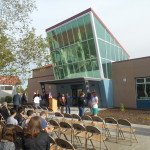
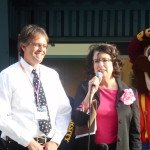
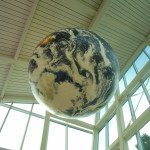
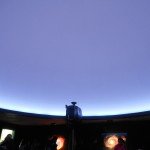
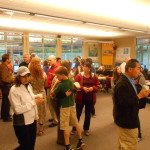
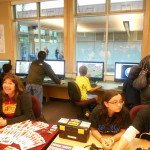
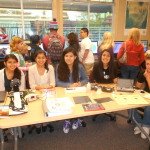
Recent Comments